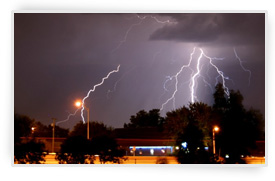Dangerous lightning bolts
 Floods and hurricanes usually can be predicted, but lightning storms often arrive unexpectedly. Sometimes dark clouds are seen and thunder is heard in the distance, indicating that a lightning storm may precede the rainstorm. On the whole however, lightning storms occur suddenly and, if struck, can paralyze and/or kill an individual.
Floods and hurricanes usually can be predicted, but lightning storms often arrive unexpectedly. Sometimes dark clouds are seen and thunder is heard in the distance, indicating that a lightning storm may precede the rainstorm. On the whole however, lightning storms occur suddenly and, if struck, can paralyze and/or kill an individual.
Lightning is defined as an atmospheric discharge of electricity that typically occurs during thunderstorms. It always seeks the shortest path to the ground, so it nearly always hits the tallest object in an area.
Types of Lightning
There are four common types of lightning:
1. Intracloud Lightning:
The first type, the most common, takes place inside a cloud and is called an intracloud lightning. This type of lightning is veiled by the cloud mass and may lead to what is sometimes called “sheet lightning.” While impressive, this type of lightning is harmless as far as its possible threat to humans and impact on the earth’s surface.
2. Intercloud Lightning:
The second type of lightning strikes from cloud-to-cloud, usually at very high altitudes, and is called intercloud lightning. These bolts of lightning between clouds can easily be seen as they move from cloud-to-cloud. This is of no danger to humans on the ground; however, they may become hazardous to aircrafts.
3. Cloud-to-Ground Lightning:
The third type of lightning, that the most feared, is the cloud-to-ground lightning, which hurtles to the earth from the dark skies. It may be reassuring to know, however, that by the time we hear the thunderclap, the immediate danger has already passed.
4. Ground-to-Cloud Lightning:
The last lightning type, which closely resembles the cloud-to-ground lightning, is the ground-to-cloud lightning, also referred to as triggered lightning. Favourable places for triggering this type of lightning are high mountain peaks, tall television towers, radio towers and skyscrapers.
Lightning Safety
Many of the more common injuries caused by lightning are severe external and internal burns, as the electric current passes through the body. However, persons can survive this horrible experience if first aid is applied immediately. The following are some safety tips to keep in mind to protect you from lightning.
If You are Indoors During a Lightning Storm
1. Stay indoors, and do not venture outside, unless it is absolutely necessary.
2. Do not stand in doorways or near open windows. Lightning can strike anywhere, and it can jump through open spaces.
3. Turn off electric breakers and disconnect appliances. Lightning is electricity and will follow electrical circuits.
4. Avoid touching electrical plugs, refrigerators, television sets, electric razors and electric hair dryers.
5. Avoid metal objects such as stoves, water pipes and sinks.
6. Do not use the telephone during the lightning storm as lightning may strike the lines outside.
7. Do not take showers and/or wash clothes or dishes during a lightning storm.
8. Do not lie flat on the ground as electrical currents can travel along the ground surface.
If You are Outside During a Lightning Storm
1. Seek shelter in a building., not a small isolated shed or any small structure that is in an open area. If no building is available your best protection is a dry ditch.
2. Do not be the tallest object in an open area. Get well away from hilltops and trees and curl into a ball. Never take shelter under a tree! If you cannot get to a shelter stop or sit on some dry clothes, which serves as an insulator and can offer some protection.
3. If you are at school stay away from playing fields and other open spaces. All outdoor activities should be suspended. Never climb or stay in a tree or on outdoor play equipment during a lightning storm!
4. You can avoid lightning. If you hear a storm coming do not waste time. Immediately move away from a high places and head for a shelter. Do not wait for the actual storm before you head to a shelter.
5. Do not take laundry off the clothesline.
6. Do not work on fences, telephone or power lines, pipelines or structural steel fabrications or use metal shovels.
7. Do not handle flammable materials in open containers.
8. Do not use metal objects like fishing rods or golf clubs. Golfers wearing cleated shoes on wet ground are particularly good lightning rods and will attract lightning.
9. Do not use equipment such as tractors, golf carts, motorcycles, lawnmowers or bicycles. Get off and move away from them. They can be electrical conductors.
10. Get out immediately if you are in water or in a small boat.
11. Stay in your car if you are caught in a lightning storm while travelling. Pull away from trees, power lines and other objects that might fall on your car. If lightning should strike the car, remain inside for at least half an hour to allow the electrical charge to dissipate. You can then jump out of the car without touching the car and the ground at the same time.
12. If you are on a farm try to get livestock to shelter but do not endanger yourself to do so.
Persons struck by lightning may receive a severe electrical shock and may be burned but they carry no electrical charge and can be handled safely. A person struck by lightning can often be revived by prompt cardio pulmonary resuscitation (CPR). In a group struck by lightning, the unconscious should be treated first. Those who show vital signs will probably recover spontaneously, although burns and other injuries may require treatment. Recovery from a lightning stroke is usually complete except for possible impairment or loss of sight or hearing.
